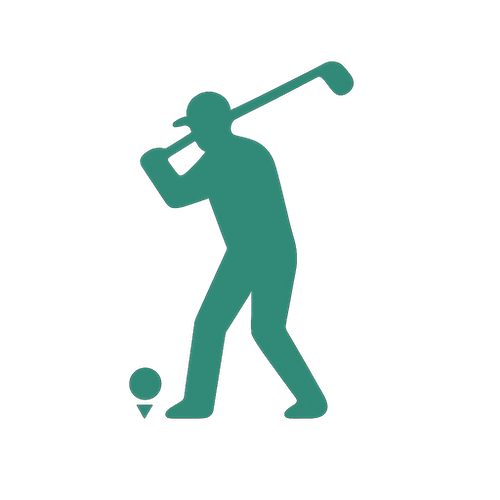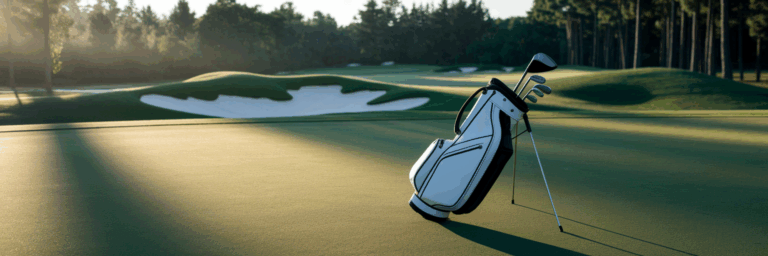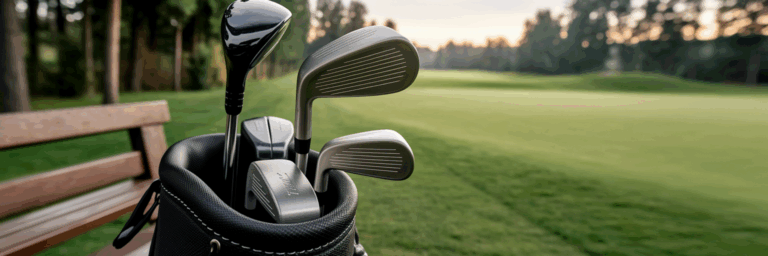A Beginner's Checklist for Testing Golf Clubs Before You Buy
Walking into a golf shop for the first time can feel like a lot. The walls are lined with shiny clubs that all look vaguely the same, and it’s easy to feel lost before you even start. But choosing your first set of clubs is a manageable and exciting first step in your golf journey.
Starting Your Search with Confidence
Before you even touch a club, the most important work happens with a quick self-assessment. Understanding your own needs is the foundation for making a smart choice. Ask yourself a few simple questions: How often do you realistically plan to play? Are you looking to jump in seriously or just enjoy a few casual rounds a year? Your answers will help you figure out how to choose golf clubs that fit your goals and budget.
For most beginners, a complete starter set is a fantastic, cost-effective entry point. These sets are designed to be forgiving and include the essential tools you need without the complexity of buying each club individually. A typical beginner set includes a driver for long shots off the tee, a few irons like a 7-iron for fairway shots, a pitching wedge for shorter shots onto the green, and a putter for rolling the ball into the hole. This combination gives you everything you need to get started on the course.
Where to Test Clubs for an Authentic Feel
Once you have a general idea of what you need, the next step is finding the right place to try some clubs out. The environment where you test can make a huge difference in how a club feels. Not all locations offer the same quality of feedback, so it’s worth being selective.
Here are the best places to get a true sense of a club’s performance:
- Dedicated Golf Retailer: Unlike a general sporting goods store, a specialty golf shop has staff who live and breathe the sport. They can offer expert advice tailored to your skill level and answer your questions with genuine insight.
- Indoor Simulators and Hitting Bays: Many stores have hitting bays equipped with launch monitors. This technology can seem intimidating, but it simply provides useful data like your swing speed and how far the ball travels. It’s a great way to get initial feedback in a controlled setting.
- The Driving Range: This is a critical step. As experts from resources like Plantation Golf highlight, seeing the actual ball flight is essential. A simulator can estimate flight, but nothing beats watching your ball soar through the air. It tells you if you’re hitting it straight, high, or with a curve.
- On Natural Grass: Hitting off the artificial mats found in most bays can be misleading. Mats are very forgiving and can make poorly struck shots look better than they are. If possible, find a spot where you can hit off real turf. This gives you an honest feel for how the club interacts with the ground, which is especially important for your iron shots.
Your In-Store Evaluation Checklist
Now that you’re in the right location, it’s time for a hands-on inspection. Before you even swing, you can learn a lot about a club just by looking at it and holding it. This part of your beginner golf club checklist helps you narrow down your options. Don’t be afraid to ask the sales staff simple questions like, “What makes this club forgiving for a beginner?” or “Can you explain the difference between these two models?”
Next, focus on the look and feel. Take your stance as if you were about to hit the ball, which is known as your address position. Does the club’s length allow you to stand comfortably without hunching over or reaching too far? Also, check the shaft flex, which is usually printed on the shaft. Beginners often benefit from a more flexible shaft (labeled 'Regular' or 'Lite') because it can help generate more swing speed and get the ball airborne more easily. This is a key factor when considering what to look for in golf clubs.
| Club Component | What to Check | Why It Matters for a Beginner |
|---|---|---|
| Grip | Feel for tackiness, not slipperiness. Check for wear or cracks. | A secure grip builds confidence and prevents the club from twisting in your hands. |
| Shaft | Look for any dents or rust. Check the label for its flex (e.g., 'R' for Regular). | The right flex helps generate club speed and a higher ball flight, making it easier to get the ball airborne. |
| Clubhead | Check the face for excessive wear. Ensure it sits flat on the ground at address. | A clubhead designed for forgiveness (larger size) will help shots fly straighter on off-center hits. |
Note: This table provides a simple framework for a visual and tactile inspection in the store. These checks help you quickly identify clubs that are a good starting point for swing testing.
Gauging Performance During Your Test Swings
With a few promising clubs in hand, it’s time for the most important part: hitting some balls. The goal of testing golf clubs for beginners isn’t to hit the ball a mile. Instead, you’re looking for comfort, consistency, and confidence. Focus on the concept of forgiveness, which simply means the club has a large sweet spot that helps your less-than-perfect shots still fly relatively straight and far. For a beginner, a club that produces decent results consistently is far more valuable than one that hits one great shot out of ten.
Take 5 to 10 swings with each club you’re seriously considering. As you do, pay attention to these key factors:
- Comfort and Consistency: Does the swing feel natural and smooth? Are your shots landing in a similar area each time, even if they aren’t perfect? You’re looking for a club that feels like an extension of your arms.
- Sound and Feel: A well-struck shot should produce a solid, satisfying sound. If you feel a harsh vibration in your hands, it could be a sign of a mishit or that the club isn’t a good match for your swing.
- Ball Flight: Is the ball getting into the air without too much effort? A club that helps you launch the ball high and relatively straight will make the game much more enjoyable.
Finally, don’t forget the putter. It’s the most used club in your bag, so spend some time on a practice green. Focus on how easy it is to aim, the feel of the ball coming off the face, and whether you can control your distances on both short and long putts.
Considering a Professional Club Fitting
You might hear people talk about a professional club fitting and wonder if it’s necessary for a beginner. While it’s not mandatory, a golf club fitting for beginners can be a valuable investment in your enjoyment of the game. A fitting goes beyond a simple store test. A professional fitter uses launch monitor data and their expertise to match clubs to your specific body type, posture, and swing.
So, is it worth the cost? Think of it as a long-term investment. Properly fitted clubs can help you develop good habits from the start and make the learning process less frustrating. As PGA Tour insiders writing for platforms like GolfWRX often emphasize, a fitting ensures your equipment is working with you, not against you. During a session, you’ll warm up, hit shots with different club combinations, and the fitter will analyze the data to recommend the ideal specifications for you. It takes the guesswork out of the equation and ensures your first set is the right one.
Making Your Final Choice with Confidence
After all the research and testing, it’s time to make a decision. Trust your instincts. Often, the right club is the one that simply feels good in your hands and gives you a sense of confidence when you stand over the ball. Don’t get too bogged down in technical details. The best choice is a club that you’re excited to use.
To make your final choice, just confirm these three things:
- It fits your budget and your playing goals.
- It feels balanced and comfortable to swing.
- It produces reasonably consistent results that make you feel good about your shots.
Remember, learning how to play golf is a journey, not a destination. Getting a set of clubs that you trust is a fantastic first step. Now, get out there and enjoy the game.









